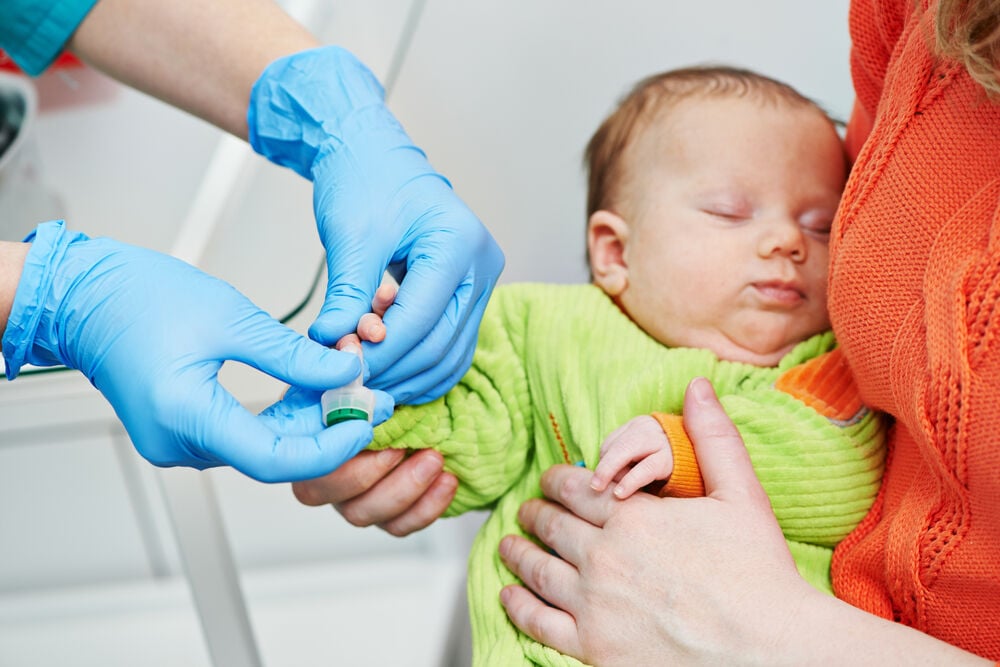Hyperbilirubinemia sounds scary, especially to new parents, but hyperbilirubinemia is a condition that occurs in about 60% of full-term newborns and about 80% of premature babies. It’s a common issue where the blood contains too much bilirubin, causing the skin to turn yellow. If not caught early, it can cause varying degrees of damage. So what do you need to know about it? Let's dive in.
-
Tracking cycle
-
Getting pregnant
-
Pregnancy
-
Help Center
-
Flo for Partners
-
Anonymous Mode
-
Flo app reviews
-
Flo Premium New
-
Secret Chats New
-
Symptom Checker New
-
Your cycle
-
Health 360°
-
Getting pregnant
-
Pregnancy
-
Being a mom
-
LGBTQ+
-
Quizzes
-
Ovulation calculator
-
hCG calculator
-
Pregnancy test calculator
-
Menstrual cycle calculator
-
Period calculator
-
Implantation calculator
-
Pregnancy weeks to months calculator
-
Pregnancy due date calculator
-
IVF and FET due date calculator
-
Due date calculator by ultrasound
-
Medical Affairs
-
Science & Research
-
Pass It On Project New
-
Privacy Portal
-
Press Center
-
Flo Accuracy
-
Careers
-
Contact Us
Is Hyperbilirubinemia as Dangerous as It Sounds?

Every piece of content at Flo Health adheres to the highest editorial standards for language, style, and medical accuracy. To learn what we do to deliver the best health and lifestyle insights to you, check out our content review principles.
What is hyperbilirubinemia?
You’ve likely had many questions when it comes to your newborn, and if your child's skin starts turning a yellow color, it generally gives rise to some concern.
As mentioned above, hyperbilirubinemia is a condition where too much bilirubin is present in your baby’s blood. Why does this happen? Red blood cells usually last about 120 days (and in neonates, the lifespan of red blood cells is shorter) before they break down and are replaced by new red blood cells.
This cycle occurs again and again in the human body, and bilirubin is created as a sort of byproduct from this process.
While the human body generally excretes this byproduct, the body of a baby with hyperbilirubinemia is unable to keep up with excreting the amount of bilirubin produced. This is due to hepatic immaturity, as well as the absence of gut flora, which impedes the elimination of bile pigment. The placenta did this job while in the mother's womb, and now the liver is taking over this function.
As a result, bilirubin may build in the baby’s blood. It ends up in other tissues, causing your baby’s skin to take on a yellowish tinge. It may also cause the eyes to appear slightly yellow, as well.
It's important to note that this is frequently a normal response that occurs during a baby’s first few days of life, as the liver slowly learns to keep up with the amount of bilirubin produced. In rare cases, however, it may be due to inadequate liver function, infection, lack of breastfeeding, or substances in breast milk itself.
How common is hyperbilirubinemia?
Hyperbilirubinemia is very common, occurring in about 50% of full-term babies and 80% of premature babies. Furthermore, mothers that have diabetes or mothers with Rh disease are more likely to give birth to babies with hyperbilirubinemia.
Symptoms of hyperbilirubinemia
While hyperbilirubinemia may manifest differently in different babies, the following three symptoms are the most common and most noticeable when it comes to determining if your child has hyperbilirubinemia:
- Your baby’s skin and eyes begin to appear yellow, starting with the face and then continuing down the rest of the body.
- Your baby experiences a lack of or difficulty feeding.
- Your baby appears more lethargic and fatigued than expected.
As a parent, you should also know that these symptoms may indicate other disorders or diseases. If you notice any changes in your babies skin, energy levels, or feeding habits, consult with your pediatrician.
Causes of hyperbilirubinemia
There are various causes of hyperbilirubinemia, including the following:
- Physiological jaundice. This refers to the most common cause, which is your baby’s inability to keep up with the bilirubin produced as the liver begins to take over the function of getting rid of bilirubin. This often happens within the first 3–5 days of a baby’s life.
- Breast milk jaundice. A specific substance in breast milk creates this type of jaundice. This substance causes the baby’s intestinal tract to reabsorb bilirubin, which results in too much of it in the baby’s body. Approximately 2% of babies will develop this type of jaundice, and it may persist for up to 12 weeks. As a mother, it’s important to know what’s safe and what’s not safe to consume when breastfeeding in order to reduce the chances of this from occurring.
- Breastfeeding failure jaundice. As you know, breastfeeding has various benefits for you and your baby, and breastfeeding frequently continues throughout the first year of your baby’s life. But some babies may experience difficulties when it comes to breastfeeding, including refusing to feed or becoming cranky when it's time to feed. If your baby isn’t getting enough breastmilk, he or she may become dehydrated and have reduced urine output, which can result in the accumulation of bilirubin in the blood. Premature babies are more likely to have this type of jaundice, but it may also occur in full-term babies as well.
- Hemolysis jaundice. This type is also fairly common and happens as a result of the breakdown of red blood cells and the baby’s inability to keep up with the bilirubin produced. It's also common in babies with Rh disease, which means they have a different blood type from their mother.
- Poor liver function jaundice. Just as the name indicates, this type of jaundice may arise from inadequate liver function and the liver’s inability to keep up with the bilirubin being produced. Sometimes it can be caused by infection, though in many cases it's simply the baby’s body adjusting to not having the placenta present.
How is hyperbilirubinemia diagnosed?

Take a quiz
Find out what you can do with our Health Assistant
Hyperbilirubinemia is diagnosed via bilirubin levels, red blood cell counts, or blood type testing indicating Rh disease. If hyperbilirubinemia appears based on symptoms within the first few days of a baby’s life, it is often attributed to physiological factors, such as the liver getting used to its function. If jaundice (discoloration) appears after a week, it may indicate more serious issues, such as an infection.
Treating hyperbilirubinemia
Treatment of hyperbilirubinemia varies based on the root cause and how high bilirubin levels measure in at. Treatment may also vary based on your baby’s age and overall health.
In case of physiologic jaundice, there is typically no treatment. If bilirubin levels are greater than 15-20 mg/dl, phytotherapy is indicated regardless of the cause. This is a light treatment that can help reduce bilirubin levels in your baby. Bilirubin absorbs regular light, but when the baby is put under more specialized blue spectrum lights, bilirubin levels decrease. This type of treatment can show major changes in a couple of hours, or it may have to be used every night and day until the symptoms subside.
During treatment, your baby’s eyes are protected with special and comfortable equipment, and his or her temperature is kept under a close watch throughout the process. Fiberoptic blankets are another form of phytotherapy that may be used alone or in combination with the above treatment method.
In severe cases of hyperbilirubinemia, doctors may recommend an exchange transfusion, which involves exchanging blood via a vein or artery. This is often done if bilirubin levels are particularly high, as it helps lower them quickly, while also providing fresh and new red blood cells.
Other treatments include addressing the underlying causes leading to hyperbilirubinemia. This may involve attempting adequate hydration through breastfeeding or finding ways to solve an infection that has occurred.
Can hyperbilirubinemia be prevented?
Hyperbilirubinemia can’t necessarily be prevented; however, picking up on early signs and recognizing changes in your baby can help prevent it from progressing into a more dangerous condition.
Know the signs and keep an eye out for them. And remember, this is a common condition. As long as you seek out medical help upon the onset of noticeable signs of hyperbilirubinemia, your baby should be just fine.
If you’re experiencing any postpartum anxiety regarding your child’s health, there are ways to manage your symptoms so that you can continue to be at your best for your baby. Being a new parent is tough work, but doing your research and due diligence is taking a step in the right direction toward gaining the knowledge you need. In a way, parents are superheroes — and you’re doing the best you can!


Hey, I'm Anique
I started using Flo app to track my period and ovulation because we wanted to have a baby.


The Flo app helped me learn about my body and spot ovulation signs during our conception journey.


I vividly
remember the day
that we switched
Flo into
Pregnancy Mode — it was
such a special
moment.
Real stories, real results
Learn how the Flo app became an amazing cheerleader for us on our conception journey.




